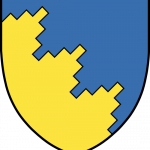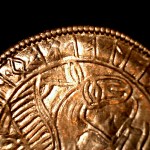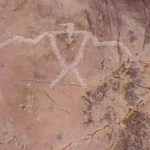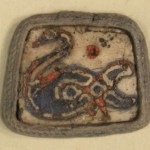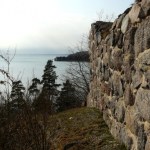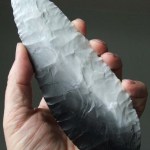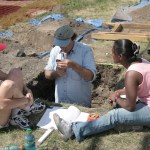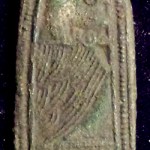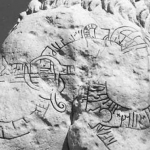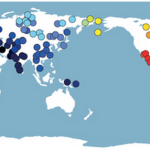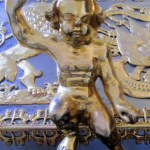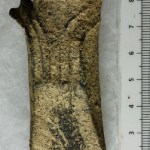archaeology
These are the work balls I'm currently juggling. All fun stuff!
Prepare for a month's excavations at two sites near Norrköping starting 23 June.
Finishing touches to Bronze Age book manuscript and illustrations.
Publish Aska in Hagebyhöga geophysics paper.
Manage Fornvännen's manuscript influx.
Edit a book by a retired heritage management official.
Schedule landscape history course in Växjö during September.
Schedule freshman archaeology in Umeå during September through November.
My excavations this summer will target the ruins of two Medieval castles near Norrköping. Christian Lovén and I have selected these two because unusually, both have curtain walls (Sw. ringmur) but do not seem to have belonged to the Crown. The High Middle Ages in Sweden are poorly documented in surviving written sources, but in one of these cases we actually have a pretty good idea who built the castle and when.
Landsjö in Kimstad parish enters the record in about 1280 when an old woman writes her will. She's Kristina, daughter of a certain Faste who had borne a plant device on his coat of…
Spent Wednesday through Friday in Estonia at the kind invitation of Marge Konsa and the Institute of History and Archaeology in Tartu. Gave a lecture on computer-aided statistics for burial studies (here's my presentation), then went to Tallinn, where Jüri Peets and Raili Allmäe showed me the finds and horrifically battle-damaged bones from the two 8th century Swedish mass burials in ships at Salme on Saaremaa. Also had time to meet with my grad school buddy Marika Mägi and do a lot of sight-seeing. Pics on Flickr!
The vibe in Estonia is optimistic and self-confident. Plaques about EU funding…
I put Tove Jansson's Moomin character the Muddler, Sw. Rådd-djuret, into a presentation. It's about multivariate statistics for archaeologists, and I accompany the picture with the following quotation.
How could you forget about the Muddler when you launched the ship, Sniff said accusingly. Did he ever get his button collection back into order?
Oh yes, many times, said Moominpappa. He came up with new button systems all the time. Sorted them according to colour or size or shape or material, or according to how much he liked them.
Amazing, Sniff said dreamily.
--- Tove Jansson 1968, The…
Fornvännen 2013:3 is now on-line on Open Access.
Morten Axboe and Magnus Källström on a classic find of runic gold bracteates from Trollhättan, recently expanded by a metal detectorist who would have been better informed about how to go about things if Swedish law had encouraged responsible metal detector clubs.
Lennart Bondeson et al. on a recently found and previously unknown type of penny from the time of King Canute, probably struck for his rebellious Danish viceroy Ulf jarl – who was also his brother-in-law. Lennart is an extremely well-informed and responsible detectorist.
Kenth Hansen…
Since late ’09 my main research project has concerned the Bronze Age in the four Swedish provinces surrounding Lakes Mälaren and Hjälmaren. I've looked at the landscape situation of the era's deposition sites, which is pretty much where you find bronze objects. Yesterday I finished the first draft of the book (except the descriptive gazetteer, into which I still need to stick a few bits). And so here it is (300 kB PDF file)! The title is:
In the Landscape and Between Worlds. Bronze Age Deposition Sites Around Lakes Mälaren and Hjälmaren in Sweden.
I would be very grateful for comments,…
This is a post I wrote elsewhere, a while ago, and just realized was never put on this blog, so here it is. I thought of this post and the topic because of the recent data of the Ms Jesus Scroll, which does indeed appear to be old. But they are still arguing about it, of course. Post is slightly revised.
A while ago I asked on my Facebook page whether anyone had seen the Dead Sea Scroll exhibit at the Science Museum of Minnesota. As one might expect, a couple of people, who possibly thought I was joking, noted that the Dead Sea scrolls were part of the Bible, and all that stuff was…
This little guy is the new face of Old Uppsala. Most likely a religious amulet, being too small for a gaming piece, he showed up as a corroded lump in a cremation grave of the Late Vendel Period, early-8th century. The same grave also yielded a lovely millefiori glass bird gem, glass beads, and very unusually for its time, molten remains of silver objects. To my knowledge this is the richest female Vendel Period grave found to date at the old nucleus of Svealand, that is, the best candidate for the grave of an 8th century Queen of the Swedes.
Read more at the Old Uppsala project blog kept by…
I drove down to Norrköping Thursday morning to look at two small Medieval castle ruins for my new project. The one at Landsjö in Kimstad is difficult to reach because it's on a small island in a lake where nobody keeps a boat. So I had bought one of those big tractor-tyre things (that people tug after their motorboats) and a hand pump, and borrowed a kayak paddle from my dad. Turned out that the textile sheath that forms the floor of the ring I was sitting in was anything but watertight, so my bottom got soaked in 5°C lake water. No matter, I was thrilled to get out to the island, which is…
Dean Snow was one of my two advisors in undergraduate school. I have fond memories of all six months of college. But that's another story. Anyway, several years ago, Dean got wind of the research showing that humans exhibit sexual dimorphism in the ratios of the middle digits of the hand. It is believed that this is accounted for by differential rates of bone growth during early development that happen to be different, on average, between males and females. There is probably not an adaptive explanation for this. Rather, at some important developmental stage there is an endocrine effect…
It is very hard for me to view the world without my Anthropological glasses, since I’ve been one kind of Anthropologist or another since I was 13 years old. Thinking about climate science deniers, I realized what makes them annoying to me. Let me tell you what I mean.
The ongoing conversation at an archaeological site.
When Archaeologists (a kind of Anthropologist, in the tradition I was trained in) dig a site, they are constantly learning about what is under ground at that location, and throughout the process develop a model of what it all means. As an aside I should mention that…
Current Archaeology #287 (February) has news of a roundhouse foundation that really caught my eye. English Iron Age roundhouses are usually visible simply as a circular ditch or a post circle. This house, at Broadbridge Heath in Sussex, had a foundation ditch shaped like a slightly open number 6: a spiral! I also enjoyed Nadia Durrani's eight-page feature on the historical archaeology of Early Modern London theatres and bear-baiting rings.
Chris Catling asks an interesting question regarding the ownership to land and to any ores under that land in the UK: these can and often do belong to…
I found an excellent argument in a recent paper by Svend Hansen,* clinching something in a particularly satisfying way.
Certain Bronze Age hoards in Northern Europe contain a lot of fragmented objects. But the pieces rarely add up to complete artefacts. In 2001 Stuart Needham argued that this may be due to a custom similar to that known e.g. from ancient Greece, where an animal was sacrificed and only certain parts that make poor eating were burnt as offerings to a god (a sleight of hand taught to humanity by Prometheus the trickster). Perhaps most scrap metal hoards from Northern Europe…
Guldgubbar are tiny pieces of gold foil with (usually) embossed motifs. They most commonly depict single men, then embracing couples, then single women, all in fine clothing. They date from the Vendel Period (540-790) and seem to have been religious artefacts. Usually they are found in the remains of elite residences, concentrating in and around roof-bearing postholes in the main hall. They form this gold-poor period's continuation of the Migration Period's gold bractate pendants and other sumptuous goldwork.
Gold foil figures weren't necessarily made where they are found. They are eminently…
The Lion of Pireus is a large 4th century BC marble statue that was moved from Pireus, the port of Athens, to Venice in 1688. It is now at the city's Arsenal. The Lion has unmistakeable Swedish 11th century runic inscriptions which have been known to Scandinavian scholars since 1798/99. Clearly they have something to do with the Varangian Guard, Swedish soldiers in the employ of the Byzantine Emperor from the 980s onward. But due to poor preservation, the message carried by those runes has been believed lost.
There is a cast of the Lion at the Historical Museum in Stockholm, and I've often…
I've blogged before about the woebegone Solutrean hypothesis, and I'm happy to say that it is now dead.
The oldest well-characterised archaeological culture in America is the Clovis culture. Its main diagnostic type is a large knapped stone spearhead with a fluted base. The Solutrean hypothesis starts from a comparison with spearheads from the Solutrean culture in south-west Europe, noting that certain Solutrean points have an outline that is similar to that of Clovis points. Is the Clovis point a typological descendant on the Solutrean point? No, say most Palaeolithic scholars, because never…
Fornvännen 2013:2, last summer's issue, is now on-line in its entirety on Open Access.
My friends Mattias Pettersson and Roger Wikell on the Stockholm area's earliest post-glacial settlement site, covered here on Aard during fieldwork in 2010.
Tony Björk and Ylva Wickberg on an early-1st millennium linear monument related to a cemetery and a river ford in Scania.
Svante Fischer et al. on how mid-1st millennium sword fittings were re-used and deposited.
Magnus Green on a 17th century angel on the run from its job as embellishment on a nobleman's sarcophagus.
Olov Gibson on the unresolved…
The list of misdemeanours that identifies an Open Access science journal as predatory and not bona fide is long. One of them is attempts on the part of the publisher and editors to manipulate the journal's citation index, for instance by demanding that authors cite earlier work published in the same journal. If many scholars cite papers in a given journal, then that journal's index improves -- even if the citing only goes on inside the covers of the journal itself.
When I first read about this criterion I was a little embarrassed, because I do that all the time when editing Fornvännen. I don'…
I've started to assemble pictures and maps for my Bronze Age book. Almost all known objects from deposition sites in the Lakes Mälaren and Hjälmaren areas have already been illustrated elsewhere. But here's an exception: a socketed bronze axe found before 1963 in a bog at Eklunda in Bred parish, near Enköping, Uppland province. It's 3,000 years old, dating from Period IV, 1100-950/20 cal BC.
Axes like this were fitted onto hafts shaped like a V with one very short arm, and held in place by a string or strap through the little lug near the base – which is damaged in this case. The verdigris…
I'm doing the final library work for my Bronze Age book. When working on a big research project, I always find it a little difficult to calibrate the most economical way to schedule my reading. Of course, I have to know early on what's in the literature on the subject I'm working with. But I also like to start writing early. And I'd rather not put too much time into re-reading stuff after I've figured out how it's relevant to my theme. I read some of it before I start writing, most of it while I'm writing, often at the computer, and then I inevitably save some of it until I'm almost done…
